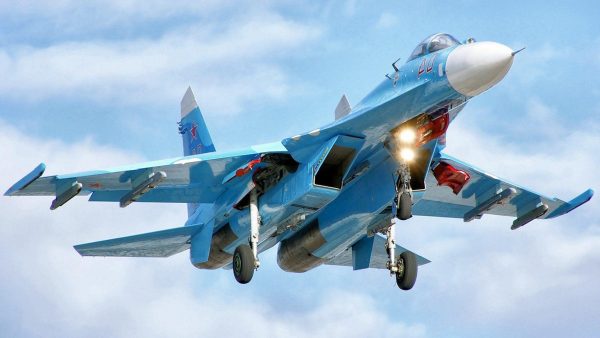This article first appeared in Warrior Maven, a Military Content Group member site.
(Washington DC) The Su-27 flanker may have emerged in the 1980s, yet the aircraft has not only been substantially upgraded but also influenced a generation of advanced Russian fighter jets. Surprisingly, its speed and thrust-to-weight ratio rival those of an F-22, and the Cold War-era jet remains a formidable air-attack platform.
Russia’s Su-27 fighter is a legend for many apparent reasons, given its speed, thrust-to-weight ratio, and bomb-attack capabilities. While not as new as the Su-57 Felon, nor is it stealthy, it has influenced Russian fighter design for decades.
Su-27
Russia’s large fleet of Su-27 ‘Flanker’ fighter jets continues to have a substantial and lasting impact on the country’s Air Force because of its bomb-carrying capacity and influence upon subsequent variants such as the Su-30 and Su-35.
The 1980s-era Su-27 has evolved into a number of critical variants including the Su-34 fighter-bomber and 4th-Gen ++ Su-35, among others. The aircraft has been in service for many years and available specs state it operates at high speeds of Mach 2.3 and with an impressive thrust-to-weight ratio of 1.09.
The Su-27 can also function in a “bomb truck” capacity as it operates with 10 hardpoints and is, not surprisingly, comparable in many respects to the MiG-29 fighter introduced just a few years prior.
While the jet clearly is not “stealthy” in the modern sense of the term, the Su-27 does seem to resemble some radar signature-lowering features such as a rounded nose, blended or nearly horizontal wing-body structure, and F-22-like dual-engine integration into the fuselage.
Fewer sharp, angled, or “protruding” hard edges certainly generate a much smaller radar return signature as electromagnetic “pings” have fewer shapes off of which to bounce and deliver a rendering. In terms of body configuration, both the Su-27 and its Su-35 successor have an F-22-like fuselage.
Already have an account? Sign In
Two ways to continue to read this article.
Subscribe
$1.99
every 4 weeks
- Unlimited access to all articles
- Support independent journalism
- Ad-free reading experience
Subscribe Now
Recurring Monthly. Cancel Anytime.
Su-27s & Su-35s
Russia’s fleet of 1985-era Su-27s is quite large and listed at 359 aircraft, according to a Russian publication listed as The Center for Analysis of World Arms Trade.
The largest influence of the Su-27 appears not only to be its large fleet size but the impact upon its high-risk follow-on variants such as the Su-35 and now emerging Su-35S. Russia operates upgraded 4th-generation Su-35 aircraft as well as Su-30s.
Both the Su-34s and Su-35s are cited as “fighter aircraft” emerging as recently as 2014. The Su-34 is listed as a “fighter-bomber” with long-range strike capacity and the Su-35 is reported to be a multi-role heavy combat fighter.
The Russian Su-35 could almost be viewed as a quasi-stealthy hybrid mix of advanced fourth-generation fighter jet technology and the early boundaries of what is called 5th-generation.
Su-35
While available specs say Russia operates 110 Su-35s, a number which is certainly substantial, it is unclear just how many of them have already been upgraded with the Su-35 ++ variants.
Should Russia have large numbers of upgraded Su-35s, their inability to achieve air superiority remains even more mysterious, especially given the sheer number of 4th-generation fighters reported to be part of Russia’s air fleet.
The Su-35 configuration includes a blended wing-body configuration and horizontal fuselage, which makes it look stealthier than an F-18 Super Hornet with an almost F-22-like rounded wing-body and dual exhaust. The Russian Su-35 configuration looks stealthy enough to have potentially inspired designs for the emerging Russian Su-57, a 5th-generation stealth aircraft.
Russia’s TASS news agency describes the “heavily upgraded” Su-35S as a maneuverable, multi-purpose fighter jet developed on the “basis of 5th-generation technologies.” The “++” refers to new avionics, communications, radar technology, and what the paper calls “plasma ignition engines” to increase thrust vectoring. Much like a 5th-generation jet, the additional thrust vectoring technology enables the Su-35 to achieve supersonic speed without using an afterburner, the paper claims.
This is quite significant as it can of course perform high-speed maneuvers and also support longer “dwell time” and attack mission duration in high-threat environments.











COMMENTS
You must become a subscriber or login to view or post comments on this article.